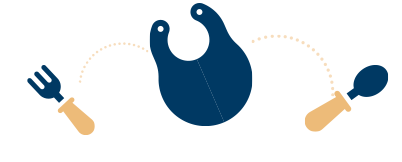Weaning is the time when a baby is introduced to solid foods and starts to decrease the amount of breast milk or standard infant formula they are taking.
When you feel that your baby is showing signs that they are ready to wean, such as:
- Being curious and interested when others around them are eating
- Having good hand-to-eye coordination
- Sitting well when supported and being able to hold up their head
- Your dietitian will advise you on the weaning process.
The information provided is intended for use alongside the advice given by a Healthcare Professional.
Weaning is a fun, exciting (and messy!) time.
Weaning a baby with PKU is the same as weaning a baby who does not have PKU, with a few additional considerations:
• It may be recommended by your dietitian that you start weaning earlier than 6 months of age (but never before 17 weeks)
• You will need to actively encourage the consumption of exchange-free foods
• You will need to introduce a new type of protein substitute – a second stage protein substitute
• You will need to gradually introduce phe containing foods
It’s best to choose a meal time when your baby is most receptive and hungry, this is often breakfast or lunch time as later in the day babies tend to tire out and may not be as eager.
When a baby first starts to wean, they will be having such small amounts of food, that they will still need the same amount of breast/bottle feeds to meet their nutritional needs. Over the age of 6 months, the special formula should not exceed a total of 500-600mls a day. This is to encourage your baby’s appetite for food.
Introducing exchange-free foods to your baby is an ideal chance to get them used to the many foods they can enjoy in their diet.
It’s usual to start weaning by offering “tastes” of exchange-free foods after a feed. These “tastes” or teaspoons are initially of single exchange-free foods (such as puréed carrot or sweet potato) at one meal time to allow baby to get used to the taste of the food offered.
If babies are offered a variety of exchange-free foods during weaning, this means they will be more likely to accept these foods in the longer term. It can often take at least 8-10 times of offering and tasting a food before your baby will accept the taste. As exchange-free foods do not have to be restricted in the PKU diet – encouraging acceptance of foods from this group will not only help them to meet their daily energy needs, but also increase the variety and choice they have at mealtimes in future.
Once an appetite for exchange-free foods has been established and your baby is managing about 10 teaspoons of exchange-free weaning foods at each mealtime after their feed, it is probably time to move on to the next stage of introducing controlled amounts of natural protein from foods in the form of phe exchanges.




